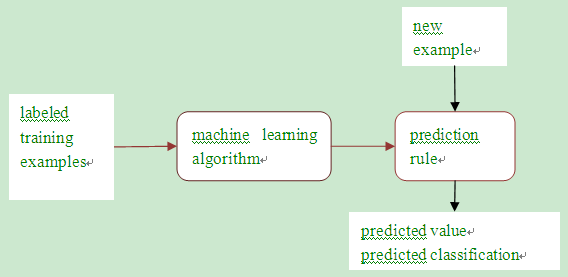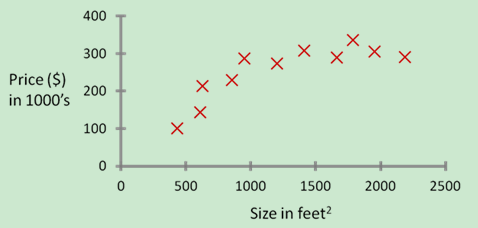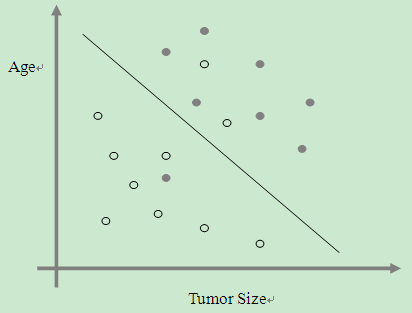(原创)Stanford Machine Learning (by Andrew NG) --- (week 1) Introduction
最近学习了coursera上面Andrew NG的Machine learning课程,课程地址为:https://www.coursera.org/course/ml
在Introduction部分NG较为系统的概括了Machine learning的一些基本概念,也让我接触了一些新的名词,这些名词在后续课程中会频繁出现:
| Machine Learning | Supervised Learning | Unsupervised Learning | Regression Problem | Classification Problem | Octave |
| 机器学习 | 有监督学习 | 无监督学习 | 回归问题 | 分类问题 | Octave |
What is Machine Learning
Definition: A computer program is said to learn from experience E with respect to some task T and some performance measure P, if its performance on T, as measured by P, improves with experience E.

Example of Machine Learning
Suppose your email program watches which emails you do or do not mark as spam, and based on that learns how to better filter spam.
T: Classifying emails as spam or not spam; (目标)
E: Watching you label emails as spam or not spam; (算法 + 数据)
P: The number (or fraction) of emails correctly classified as spam/not spam. (评价方法->损失函数)
Supervised Learning
Definition: The goal is, given a labeled training data, to learn a function h so that h(x) is a “good” predictor for the corresponding value of y. A pair (x, y) is called a training example, x denoting “input” variables, also called features, and y denoting “output” or target variable that we are trying to predict.
When the target variable that we are trying to predict is continuous, we call the learning problem a regression problem. When the target can take on only a small number of discrete values, the learning problem is called a classification problem.
A.Example of Regression Problem
Suppose we have a dataset giving the living areas and prices of 11 houses from Portland, Oregon:
| Living area (feet2) | Price (1000$s) |
| 450 | 100 |
| 600 | 140 |
| 620 | 210 |
| ... | ... |
We can plot this data:

So regression problem is to find a function h to fit these points.
B.Example of Classification Problem
Suppose we have a dataset giving the tumor size, patient age and malignant or benign, we plot these data as follows:

So classification problem is to find a function h to sperate these points.
PS: 回归就是找出那个可以拟合样本的函数(平面,空间,...),分类就是找到那个可以把不同类别的样本分开的函数(平面,空间,...);在特定问题下,比如逻辑回归问题,分类问题就可以被视作回归问题来解决。
Unsupervised Learning
In the clustering problem, we are given a training set {x(1), . . . , x(m)}, and want to group the data into a few cohesive “clusters”. Here, no labels y(i) are given. So, this is an unsupervised learning problem.
PS: 无监督学习很多时候都暗指聚类算法,聚类算法又分硬聚类(K-means, 分层聚类,基于密度的等等)和软聚类(EM算法)。
(原创)Stanford Machine Learning (by Andrew NG) --- (week 1) Introduction的更多相关文章
- (原创)Stanford Machine Learning (by Andrew NG) --- (week 10) Large Scale Machine Learning & Application Example
本栏目来源于Andrew NG老师讲解的Machine Learning课程,主要介绍大规模机器学习以及其应用.包括随机梯度下降法.维批量梯度下降法.梯度下降法的收敛.在线学习.map reduce以 ...
- (原创)Stanford Machine Learning (by Andrew NG) --- (week 8) Clustering & Dimensionality Reduction
本周主要介绍了聚类算法和特征降维方法,聚类算法包括K-means的相关概念.优化目标.聚类中心等内容:特征降维包括降维的缘由.算法描述.压缩重建等内容.coursera上面Andrew NG的Mach ...
- (原创)Stanford Machine Learning (by Andrew NG) --- (week 7) Support Vector Machines
本栏目内容来源于Andrew NG老师讲解的SVM部分,包括SVM的优化目标.最大判定边界.核函数.SVM使用方法.多分类问题等,Machine learning课程地址为:https://www.c ...
- (原创)Stanford Machine Learning (by Andrew NG) --- (week 9) Anomaly Detection&Recommender Systems
这部分内容来源于Andrew NG老师讲解的 machine learning课程,包括异常检测算法以及推荐系统设计.异常检测是一个非监督学习算法,用于发现系统中的异常数据.推荐系统在生活中也是随处可 ...
- (原创)Stanford Machine Learning (by Andrew NG) --- (week 4) Neural Networks Representation
Andrew NG的Machine learning课程地址为:https://www.coursera.org/course/ml 神经网络一直被认为是比较难懂的问题,NG将神经网络部分的课程分为了 ...
- (原创)Stanford Machine Learning (by Andrew NG) --- (week 1) Linear Regression
Andrew NG的Machine learning课程地址为:https://www.coursera.org/course/ml 在Linear Regression部分出现了一些新的名词,这些名 ...
- (原创)Stanford Machine Learning (by Andrew NG) --- (week 3) Logistic Regression & Regularization
coursera上面Andrew NG的Machine learning课程地址为:https://www.coursera.org/course/ml 我曾经使用Logistic Regressio ...
- (原创)Stanford Machine Learning (by Andrew NG) --- (week 5) Neural Networks Learning
本栏目内容来自Andrew NG老师的公开课:https://class.coursera.org/ml/class/index 一般而言, 人工神经网络与经典计算方法相比并非优越, 只有当常规方法解 ...
- (原创)Stanford Machine Learning (by Andrew NG) --- (week 6) Advice for Applying Machine Learning & Machine Learning System Design
(1) Advice for applying machine learning Deciding what to try next 现在我们已学习了线性回归.逻辑回归.神经网络等机器学习算法,接下来 ...
随机推荐
- 关于js闭包官方解释庖丁解牛式理解
闭包:是一个拥有许多变量和绑定了这些变量的环境的表达式(通常是一个函数),因而这些变量也是该表达式的一部分. 变量+环境 首先按这个句子主谓宾来分解.闭包是一个表达式,通常是一个函数. 这意味着第一它 ...
- hdu1002 A + B Problem II(大数题)
题目链接:http://acm.hdu.edu.cn/showproblem.php?pid=1002 A + B Problem II Time Limit: 2000/1000 MS (Java/ ...
- Ribbon的主要组件与工作流程
一:Ribbon是什么? Ribbon是Netflix发布的开源项目,主要功能是提供客户端的软件负载均衡算法,将Netflix的中间层服务连接在一起.Ribbon客户端组件提供一系列完善的配置项如连接 ...
- SQL注入文件读取通过from for分页读取
http://103.238.227.13:10088/?id=1 在读取文件的时候发现不能够一下子全部读取出来.经过百度学习了一下,看到别人使用from for说实在此前真不知道这操作. 先来看一下 ...
- 【Python学习笔记】多版本python使用pip安装第三方库
不知道是不是有人跟我一样,一直Python2与Python3混着用,然而在cmd中默认的Python版本只有一种,使用 pip install xxx(第三方库名) 只会安装到默认版本上. 而如果需 ...
- JS中的日期内置函数
用JS中的日期内置函数实现在页面显示:“今天是:2013年9月26日14:32:45”. var date=new Date(Date.parse('9/26/2013 14:32:45')); ...
- FineReport——JS二次开发(分页预览)
BS访问某个cpt模板,报表servlet将会将cpt文件解析成对应的html,报表内容最终转换为一个table,位于id=content-container的div中. 在模板和html页面中,他们 ...
- XML 约束 (DTD和 schema)
book.DTD 如下: <?xml version="1.0" encoding="UTF-8" ?> <schema xmlns=&quo ...
- 步骤一:下载jdk并安装和配置java环境变量
1.下载JDk地址: http://download.eclipse.org/oomph/jre/?vm=1_1_7_0_64_0 2.进入下载页面(下载的是jdk7),点击:Oracle JDK1. ...
- 其实linux下远程windows并不麻烦
1:如果你是安装的ubuntu.那么安装完成之后就自带一个Remmina的远程桌面工具 2:这里我们需要安装rdesktop和tsclient,其中rdesktop是基于命令行的工具,tsclient ...
